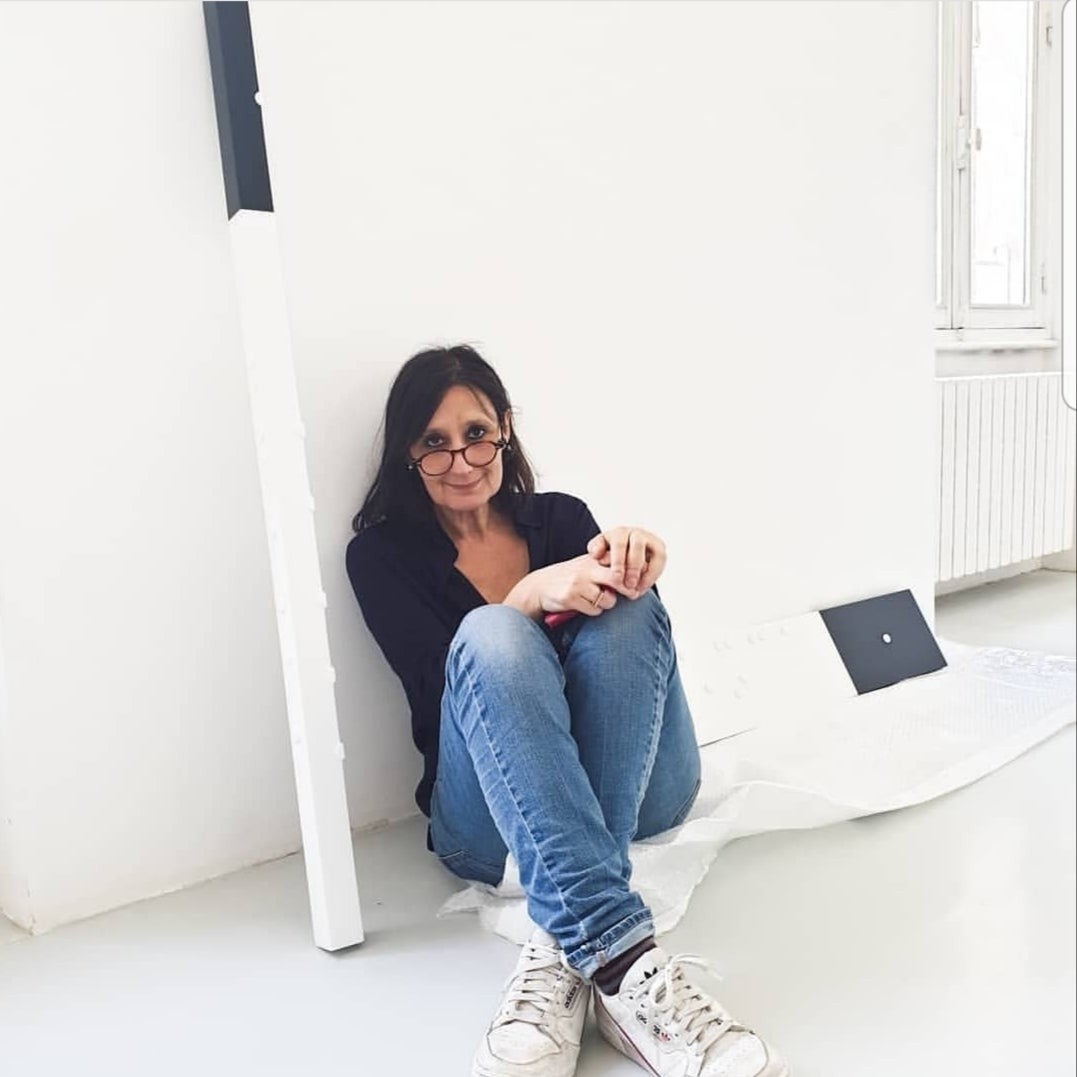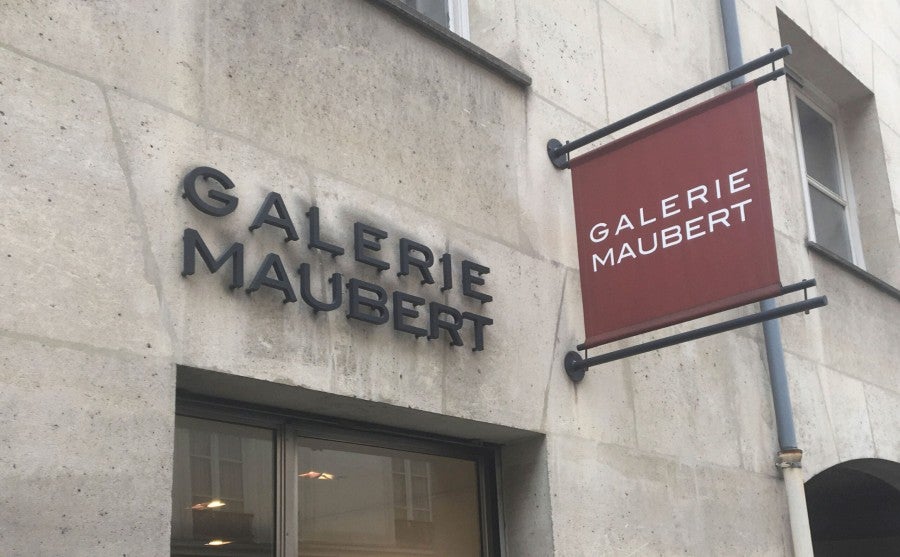« Motivus » ON TOUCHE AVEC LES YEUX

A solo show of Nathalie Elemento
Interview between Nathalie Elemento and Fabienne Grasser-Fulchéri,
director of the Espace de l’Art Concret at Mouans-Sartoux, 2019.
On a day-to-day basis, between presence and absence, the
conceptualisations of language naturally invite themselves to
the reflection in order to construct a line of thought. Beyond a
language opposition that could be perceived as dualistic, the
braille writing offers an intermediate area of experience, it is
about reflecting on the modes and manners of perception.
The overlap of the language construction and the braille use
points silence and the translation of the latter while following
the music scores’ musicality to introduce a sort of “gaze sono-
rity”, similar to rhythm.
F.G-F : You have chosen to materialise this text through va-
rious means such as drawing or sculpture. How do you consi-
der this offers and their relation to the spectator knowing that
some of your work can be included and other not?
N.E : All the drawings come from a set entitled if someone
speaks it becomes bright/touch with one’s eyes. We say to
children “only touch with your eyes” afraid of them making fall
or breaking an object.
If only, once grown up, we had this same capacity to touch
with our eyes… To look, for my part, is not touching but rather
touching intensively with our eyes, getting closer and closer,
trying to understand, willing to embrace all the possibilities.
In hindsight, distance is necessary to approach an object
otherwise it means that we are the object, or at least at the
same place. All is said, without distance we are doomed to
have merely one view angle.
A drawing needs and perhaps even deserves, more distance.
It is a way of thinking and a thought is continuously moving.
With the braille drawings projects, even though the feeling ex-
perience cannot be touch-sensitive, the language construction
gives another meaning and indicates a reading through the
work’s composition.
Thus, the wanted implication, here, ascertains the drawings’
dimensions depending on the phrasing’s length.
My sculptures are sculptures of use, at the complete opposite
of design, they are merely practicable rather than practical.
They are objects of thought to share and some questions need
to be raised, if one can say, with fingertips towards the feel or
at least towards the desire to feel. It is another way to perceive.
I am asking adults to touch with their eyes the drawings without
being afraid of breaking the objects. It is what I mean when I
say “sculptures of use” : it is both the visual use and the expec-
ted manner of the spectator to capture it in his gestures, his
physical or mental position, his positioning in relation with the
object’s position within the space or his thinking.
The base was born to adore what is statuary, yet, I do not want
people to adore, I want them to love. I enjoy the idea that these
sculptures in braille can be both visible and readable. All is a
question of what reading one makes of what he sees: the posi-
tion within the space close to architectural objects or the deco-
rum. Thus, a painting can become a handrail, a rug can covers
a room’s borders and not its centre anymore, a cardboard box
can change its original purpose and become a sculpture….
F-G-F : You have produced an artwork which relates to a
transmission stick that you exhibit along with its unfold version
just as a score. It is the first time that you create an object with
such density. Could you tell us a little more about the genesis
of this work?
N.E : Does the room between the stick and the painting remain
an intermediate space? Is it merely a movement? This work
was conceived within the Motivus in four times project, it is both
the pattern and the idea. “Motivation” comes from “ Motivus”,
the pattern and “motivere”, the move.
Sculpture is absurd when it comes to movement. The process
is a movement but when does one decide to say stop, it is now
said: it is true. Very present at the atelier or in the mind, the
movement disappears in aid of a pause and exhibition time to
let merely the object appear.
F-G-F : To continue on this idea of movement, you even think
about creating actual choreographies in relation to your sculp-
tures. Where does this link with dance come from?
N.E : Dance has always been a great part of my life. From
the petit bal perdu to contemporary dance, all types of dance,
without any exception. It is a very rich language whose co-
des, structures and communication means that interest me are
highly present .
Dance is a splendid drawing with a thousand dimensions within
the space, a sculpture with schemes one can only guess, play
with their structures, and speak without chatting. Dance has
this capacity to go from architecture to painting while insisting
on a body that suddenly becomes a typography. Its breadth is
extreme but its connection to the living has, until now, scared
me a little.
Motivation is the name of the project that follows up the path
of the ‘Without any apparent pattern’ where the latter is drawn
on a carpet and disappears to the aid of the motif redrawn by
the physical directions we undertake and by our body while we
wander. From walking to the pause time, then the jump and
finally the danced step(s), it is about inviting to movements.
Motivation develops the idea of the ideal base, sculptural but
which, in my approach and perspective of “sculpture of use”,
remains firmly turned towards the human.
From a crossing point to an exhibition place, it is about giving to
see but also to live both shared human and artistic situations:
the game, the wandering. And even if sculpture remains for my
part a drawn practice and a movement, I would definitively like
to collaborate with choreographers. It would be incredible to
succeed in realising objects to think about for dancing.
I am interested in other silences whose, alone, I don’t or I can-
not talk about: the frozen frames, breaks, hesitations, gaps,
avoided gazes, backs which are turned, eyes looking down,
abandonments … Other silences which can merely exist in the
gathering of people, the encounter, and that I would like to in-
vite to share and to dance.
